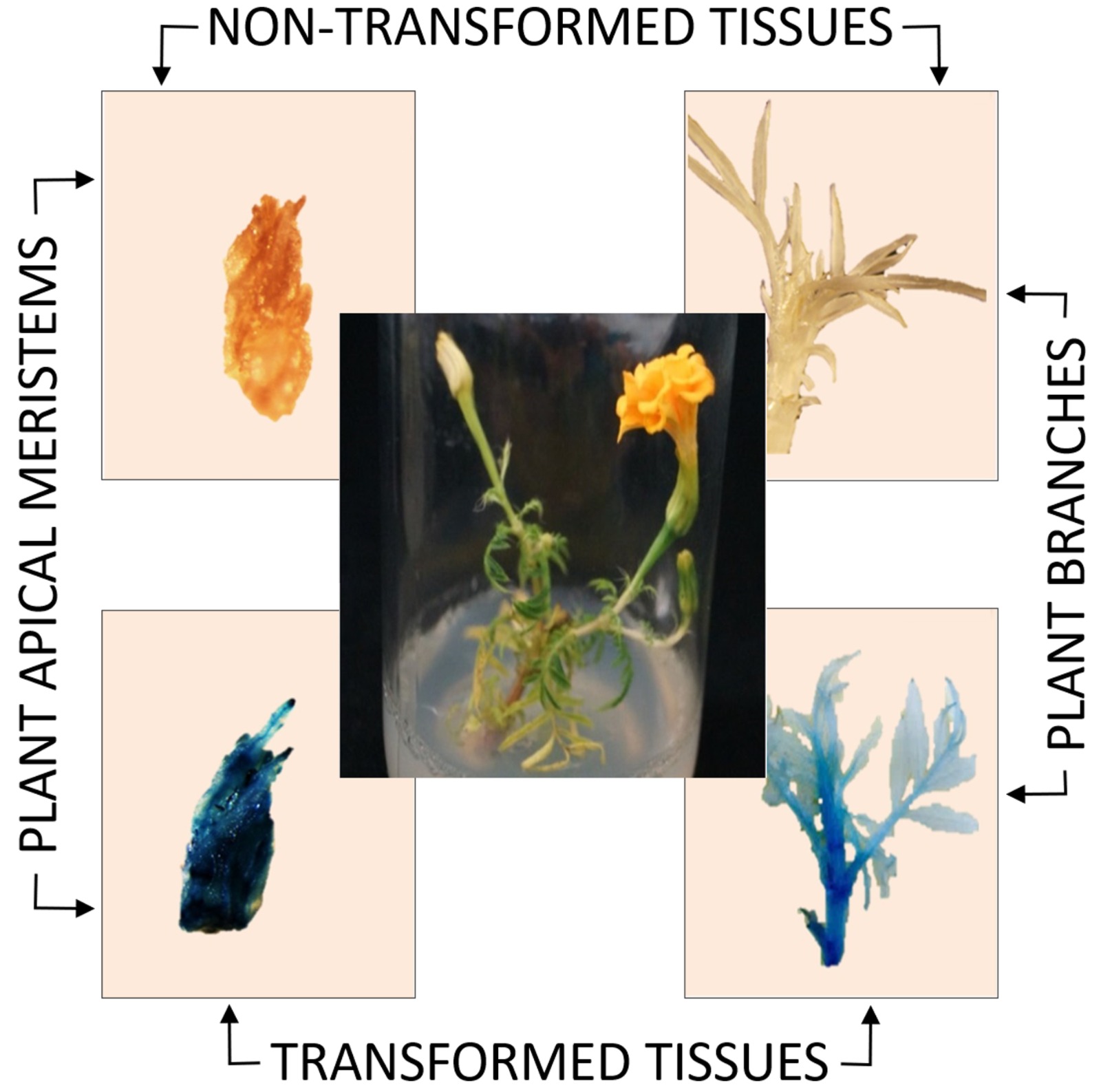Transformation of Tagetes erecta L. with the GUS Reporter Gene Via Agrobacterium tumefaciens
DOI:
https://doi.org/10.29356/jmcs.v67i3.2059Keywords:
pCAMBIA2301, Agrobacterium tumefaciens (LBA4404), Tagetes erecta L., stable transformationAbstract
Abstract. Tagetes erecta L. (var. Marvel orange) a plant native to Mexico with traditional (used in religious ceremonies, as antiparasitic, insecticide, etc.) and industrial uses (flour of young flowers is used as food supplement in chicken and crustacean farms for its high content of carotenoids). Currently, there is great interest in achieving stable genetic transformation of this species with genes of agricultural interest; thus, the objective of this work was to optimize a protocol for stable transformation of T. erecta L. Shoot-tips from in vitro seedlings were transformed with Agrobacterium tumefaciens LBA4404 strain carrying the binary vector pCAMBIA 2301. Regeneration of transformed seedlings was performed in the presence of 50 mg·L-1 kanamycin. Stable genetic transformation of plantlets was demonstrated through positive GUS staining in leaves and flowers. PCR analysis detected the presence of a 600 bp fragment of the neomycin phosphotransferase II (NPTII) gene in the genomic DNA from regenerated seedlings. Transformation frequency was 40 %. To the best of our knowledge, this work is the second report of a successful stable transformation of T. erecta L. plants with GUS reporter via A. tumefaciens. This transformation protocol can be used to introduce genes in T. erecta L. to manipulate the isoprenoids biosynthetic pathways.
Resumen. Tagetes erecta L. (var. naranja Marvel) es una planta originaria de México con usos tradicionales (utilizada en ceremonias religiosas, como antiparasitario, insecticida, etc.) e industriales (la harina de flores jóvenes se usa como complemento alimenticio en granjas de pollos y crustáceos por su alto contenido en carotenoides). Actualmente, existe un gran interés en lograr la transformación genética estable de esta especie con genes de interés agrícola; por lo tanto, el objetivo de este trabajo fue optimizar un protocolo para la transformación estable de T. erecta L. Las puntas de brotes de plántulas in vitro se transformaron con la cepa LBA4404 de Agrobacterium tumefaciens que lleva el vector binario pCAMBIA 2301. La regeneración de las plántulas transformadas se realizó en presencia de 50 mg·L-1 de kanamicina. La transformación genética estable de las plántulas se demostró mediante tinción positiva de GUS en hojas y flores. Los análisis de PCR detectaron la presencia de un fragmento de 600 pb del gen de la neomicina fosfotransferasa II (NPTII) en el ADN genómico de las plántulas regeneradas. La frecuencia de transformación fue del 40 %. Hasta donde sabemos, este trabajo es el segundo reporte de una transformación estable exitosa de plantas de T. erecta L. con el gen reportero GUS a través de A. tumefaciens. Este protocolo de transformación se puede utilizar para introducir genes en T. erecta L., para manipular las rutas de biosíntesis de isoprenoides.
Downloads
References
Vanegas, P. E.; Cruz-Hernández. A.; Valverde, M. E.; Paredes-López, O. Plant Cell, Tissue, Organ Cult. 2002, 69, 279–28. DOI: https://doi.org/10.1023/A:1015610011374.
Del Villar-Martínez, A. A.; Vanegas-Espinoza, P. E.; Paredes-López, O. Meth. Mol. Biol. 2010, 589, 213–22. DOI: http://dx.doi:10.1007/978-1-60327-114-1_20.
Gutiérrez, R. M.; Luna, H. H.; Garrido, S. H. J. Chil. Chem. Soc. 2006, 51, 883–886. DOI: http://dx.doi.org/10.4067/s0717-97072006000200010.
Rai, M. K.; Acharya, D. Compositae News. 1999, 34, 37–43. DOI: http://dx.doi.org/10.1590/S0074-02762002000700017.
Vanegas, P.; Valdez Morales, M.; Valverde, M.; Cruz Hernández, A.; Paredes López, O. Plant Cell Tiss Org Cult. 2006, 84, 359–363. DOI: http://dx.doi:10.1007/s11240-005-9030-x.
Godoy-Hernández, G.; Avilés-Berzunza. E.; Castro-Concha, L.; Miranda-Ham, M. L. Plant Cell, Tissue, Organ Cult. 2006, 84, 365–368. DOI: http://dx.doi:10.1007/s11240-005-9031-9.
Gupta, V.; Rahman, L. Protoplasma. 2015, 252, 1061-1070. DOI: https://doi.org/10.1007/s00709-014-0740-y.
Gupta, V.; Kahn, S.; Verma, R. K.; Shanker, K.; Singh, S. V.; Rahman, L. Transgenic. Res. 2022, 31, 625–635. DOI: https://doi.org/10.1007/s11248-022-00323-9.
Jefferson, R. A.; Kavanaugh, T. A.; Bevan, E. W. Europ. Mol. Biol Org. J. 1987, 6, 3901–3907.
Dellaporta, S.; Wood, J.; Hicks, J. Plant Mol. Biol. Rep. 1983, 1, 19-20. DOI: https://doi.org/10.1007/BF02712670.
Erdag, B.; Emek, Y. Turkish J. Biol. 2009, 33, 319-326. DOI: http://dx.doi:10.3906/biy-0810-2.
Maheshwari, P.; Kumar, A. In Vitro Cell Develop. Biol-Plant. 2006, 42, 589–595. DOI: https://doi.org/10.1079/IVP2006825.
Sivanesan, I.; Ryong, Jeong, B. Plant Biotechnol. 2007 24, 527–532. DOI: https://doi.org/10.5511/plantbiotechnology.24.527.
Miranda-Ham, M.; Castro-Concha, L.; Avilés-Berzunza, E.; Godoy-Hernández, G. HortScience. 2006, 41, 1518-1520. DOI: https://doi.org/10.21273/HORTSCI.41.6.1518.
Sretenovic, T.; Ninkovic, S.; Uzelac, B.; Vinterhalter, B.; Vinterhalter, D. Russ. J. Plant Physiol. 2007, 54, 738–743. DOI: https://doi.org/10.1134/S1021443707050135.
Chetty, V. J.; Ceballos, N.; García, D.; Narváez Vásquez, J.; López, W.; Orozco Cárdenas, M. L. Plant Cell. Rep. 2013, 32, 239–247. DOI: http://dx.doi:10.1007/s00299-012-1358-1.
Travella, S.; Ross, S.M.; Harden, J.; Everett, C.; Snape, J.W.; Harwood, W.A. Plant Cell Rep. 2005, 23, 780–789. DOI: http://dx.doi:10.1007/s00299-004-0892-x.
Gelvin, S. B. Microbiol. Mol. Biol. Rev. 2003, 67, 16-37. DOI: http://dx.doi:10.1128/MMBR.67.1.16–37.
Shou, H.; Frame, B.R.; Whitman, S.A.; Wang, K. Mol. Breed. 2004, 13, 201–208. DOI: https://doi.org/10.1023/B:MOLB.0000018767.64586.53.

Downloads
Published
Issue
Section
License
Copyright (c) 2023 Elidé Avilés Berzunza, Johny Avilez Montalvo, Reyna Gómez Villa, Gregorio Godoy-Hernández

This work is licensed under a Creative Commons Attribution-NonCommercial 4.0 International License.
Authors who publish with this journal agree to the following terms:
- Authors retain copyright and grant the journal right of first publication with the work simultaneously licensed under a Creative Commons Attribution License that allows others to share the work with an acknowledgement of the work's authorship and initial publication in this journal.
- Authors are able to enter into separate, additional contractual arrangements for the non-exclusive distribution of the journal's published version of the work (e.g., post it to an institutional repository or publish it in a book), with an acknowledgement of its initial publication in this journal.









